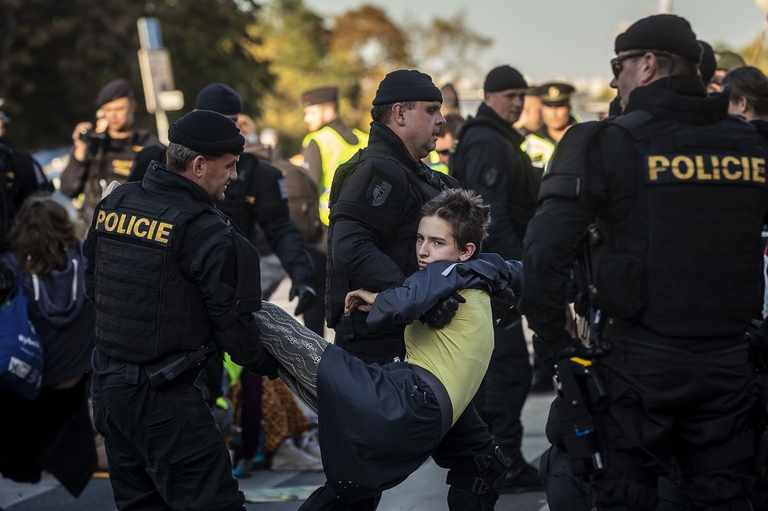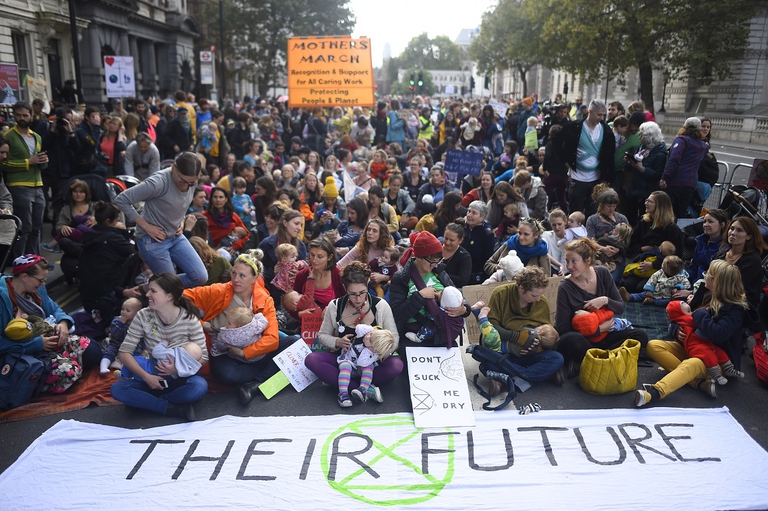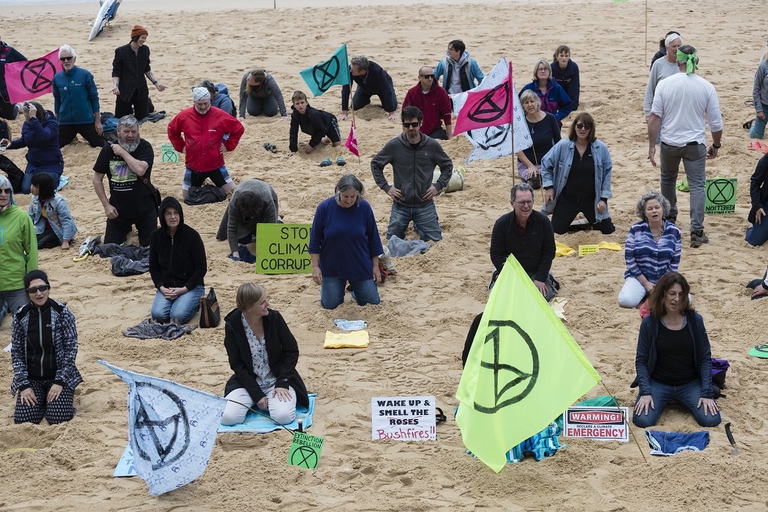
After a landslide led to twelve deaths on the island of Ischia, questions have been raised about the impacts of illegal building, tourism, and climate change.
From London to Rome, Sidney to Wellington, Extinction Rebellion (XR) activists took to the streets in peaceful protests across the globe over two weeks of the International Rebellion.
After two weeks, hundreds of acts of civil disobedience and over three thousand arrests, the International Rebellion came to a close. It had been planned by members of Extinction Rebellion (XR), the non-violent movement that came into being to ask for urgent measures against the climate crisis. Conscious that radical actions are necessary to bring about radical change, XR sent out a message of courage and hope that can’t be ignored. “Together, we will peacefully occupy the centres of power and shut them down until governments act on the Climate and Ecological Emergency,” XR wrote before launching the International Rebellion, the group’s second major protest after the one that took place last April. The demonstrations, which involved tens of thousands of people in over 60 countries across all continents, began on 7 October. In most cases it lasted a week, whereas in London, where the movement originated, protests went on for almost two weeks.
XR’s main tool in its efforts is non-violent civil disobedience, which has proven useful throughout history to bring about social and political change. The movement’s objective, which should be shared by every single human being on the planet, is to fight the climate crisis and the sixth mass extinction that is currently happening, in order to avoid the resultant societal collapse and decline of our species. Human activities are the main cause of this crisis, and it is therefore necessary to act to invert the trend. “Extinction Rebellion believes it is a citizen’s duty to rebel using peaceful civil disobedience when faced with criminal inactivity by its Government”.
The bravest, most colourful and inventive demonstrations took place in London – where XR was formed by Roger Hallam and Gail Bradbrook in May 2018. Activists, among other things, blocked roads and bridges in the city centre, stopped traffic in front of the Bank of England to “interrupt the system that finances the environmental crisis” and protested outside the Department for Transport and the airport.
Doctors and nurses also joined the protests, raising awareness of the the close ties between health and environment. Over fifty healthcare workers placed 110 pairs of shoes on the steps in Trafalgar Square, symbolising the number of lives that are cut short every day in the UK because of atmospheric pollution.
On 9 October, in the vicinity of Parliament Square, hundreds of mothers blocked a road while breastfeeding their children. The message they were endorsing is a powerful one: “Ecological devastation and the growing climate emergency means our babies’ lives are at risk. We are reaching the point where it may be too late to save them. We are here to demand that our government acts now to protect our babies”. For the last day of protesting, over 20,000 people, ignoring the ban from police forces, joined the March of Extinction, a sombre affair to grieve for the ongoing ecocide that brought Oxford Street to a standstill for several hours.
But, evidently, the protesters’ active non-violence was not well-received by those who want to maintain the status quo. On 14 October, Scotland Yard adopted a provision banning all protests by XR members, in open violation of the Universal Declaration of Human Rights. Extinction Rebellion’s activities continued regardless of the ban and the clearing of protesters from their camps. This resulted in an increase in the number of arrests, which is in itself part of the movement’s strategy: the goal is to reach such a significant number of arrests of innocuous protesters that it can no longer be ignored.
Among the most well-known figures to be arrested were Princess Marie-Esméralda, a member of the Belgian Royal Family, and George Monbiot, a British writer, journalist and Guardian columnist. Not long before his arrest, Monbiot had published an article in which he expressed a hope to end up behind bars, because “mass arrests are a potent form of democratic protest. They work because they show that the campaigners are serious. When people are prepared to jeopardise their liberty for their cause, other people appear more likely to listen to what they say, and more likely to recognise its importance. By putting our bodies on the line and risking our liberty, we make this great neglected issue impossible to ignore”.
The International Rebellion affected many different countries all over the world, once again reminding people of the wide-ranging threat caused by the destruction of the ecosystems that our lives depend on. In Amsterdam, in the Netherlands, protesters blockaded a bridge in the city centre; in Paris, France, hundreds of activists disrupted access to the National Assembly; in New York, USA, demonstrators peacefully occupied Times Square, one of the city’s biggest intersections; in Dublin, Ireland, protesters draped in leaves and branches gave life to a spectacular ‘human forest‘ before heading to Leinster House, the seat of the Irish parliament, to demand a complete revision of forestry policy.
In Italy, protests took place in Rome. Among the initiatives, like in many other parts of the world, a group of ten activists took part in a hunger strike. On 11 October, after four days of this protest, Italian Environment Minister Sergio Costa met with a delegation of hunger strikers and XR representatives, who presented him with a document containing the movement’s demands. The activists also asked to meet with Prime Minister Giuseppe Conte so that they could demand for a state of climate emergency to be declared. This, however, did not come to pass.
The reaction of law enforcement to activists’ non-violent protests was not always peaceful. Brussels, in Belgium, witnessed the most violent repression ever suffered by the movement. Police attacked protesters in the vicinity of the Royal Palace using water cannons, pepper spray (which was also used on a two-year old child), truncheons and shields, making over 400 arrests.
In Sidney, XR rebels hid their heads in the sand as a representation of their country’s government in the face of the ecological crisis. In Slovakia, activists blocked the entrance to the Ministry of Economic Affairs, as a protest against its refusal to abide by the Paris Accord. XR Turkey organised an evocative protest outside the Istanbul Biennial, an important contemporary art exhibition sponsored by an oil company. The rebels poured crude oil along the main entrance.
XR’s autumnal mobilisation is over, but the movement has stated that the rebellion has only just begun. Nowhere on earth is governments’ action commensurate to the gravity of the catastrophe our planet is facing. This is also a result of lack of information and public discussion about the climate crisis. The protests in recent weeks have brought the world’s attention to the topic, also thanks to the Global Climate Strikes and the efforts of Greta Thunberg. Our climate is a more important issue, and more hotly debated, than ever before.
A statement from XR reads: “To the government we say: we are still in rebellion and will continue to raise the alarm on the Climate and Ecological Emergency until meaningful action is taken. We urge them to work with us to protect the planet that all of us hold dear, it is time to stop harming and start repairing“.
Siamo anche su WhatsApp. Segui il canale ufficiale LifeGate per restare aggiornata, aggiornato sulle ultime notizie e sulle nostre attività.
![]()
Quest'opera è distribuita con Licenza Creative Commons Attribuzione - Non commerciale - Non opere derivate 4.0 Internazionale.
After a landslide led to twelve deaths on the island of Ischia, questions have been raised about the impacts of illegal building, tourism, and climate change.
Not much snow, peaks of 19 degrees Celsius in Norway and even 28 degrees in France: official data confirms the anomalously high temperatures of this past winter.
Extinction Rebellion, founded in May 2018, is an extremely organised and multifaceted non-violent movement that uses maths as an instrument to plan protests.
Ocean warming has risen to record highs over the last five years: just in 2019 the heat released into the world’s oceans was equivalent to that of 5-6 atomic bombs per second. The culprit, no doubt, is climate change.
What did Greta Thunberg tell participants at the 2020 World Economic Forum in Davos? Once again, the Swedish activist underlined the total lack of concrete solutions to the climate crisis presented by leaders so far.
The list of human and animal victims of the Australia wildfires keeps growing – one species might already have gone extinct – as the smoke even reaches South America.
Kivalina is located on a small island once guarded by sea ice, which is now melting due to global warming. While the sea threatens to wipe the village off the face of the Earth, its inhabitants refuse to give up their lives and traditions.
Thanks to activists, the voice of the world’s peoples resounded through the COP25 like an alarm bell. Governments didn’t reach the results they demanded, but their cries and messages were stronger than ever, reaching even those who weren’t in Madrid.
Climate change poses a risk for millions. However, women are the most vulnerable to its negative consequences: a few simple considerations by the Italian Climate Network help us perceive the global implications of this.











